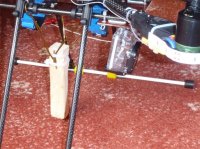Agree on the connections. As you see, it was the first thing I mentioned.
However it would not explain the difference between Atti, and GPS.
First on this, I don't think taking off in GPS mode is ever very safe. On my commonest site, I have a small shed behind me and to the right, and if I attempt to take off in GPS mode the copter will always try to go right very hard for a couple of feet. If the grass is high, this will flip the copter. I suspect the GPS signal is getting blocked or reflected at this point, and as soon as the copter starts to lift it finds itself saying 'go right hard'. Quite a few other people have reported similar behaviour. I'd always stick to Atti for the actual takeoff.

Now there is no magic number for gains, it varies from model to model, but the 100 settings are normally close enough for a model to lift and give you a starting point, unless the design is very extreme. Yes, the gains _do_ differ significantly with the latest firmware.
There is no figure for 'remote adjust'. It allows you to specify a radio input channel to adjust the gains. If this is selected, and not connected, 'no wonder' the copter won't fly. It'd be receiving either noise, or the failsafe signal from your receiver, and the gains could be set to anything!....
Sequence I've used is:
Set all figures to 100.
Set remote adjust on basic pitch and roll _only_ to remote adjust. I use the X2 channel. Then verify on the ground with your radio, that it is receiving X2, and that you know where the pot controlling this is. Turn it to the centre, so the gain is 100. On my radio I have a Aux pot, which 'beeps' in it's centre position. I adjust this so the beep is 100% gain.
Then lift off. Atti mode only.
Is it flying?. Try moving it right/left with the stick. Responses OK, or sluggish?. If responses seem slow, turn the gain up a little.
Basically the behaviour is that if the gain is too low, the copter will slowly drift right/left, and be sluggish on the responses. If to high it starts to wobble quickly. Ideal position is just under the wobble point.
Now land, shutdown, and don't move the pot. Power up the software, wake up the copter, and radio, and read what the gain boxes say. Perhaps 121% or some similar figure. Turn off the remote adjust setting, and save these gains.
You can do this for height next, switching this to remote adjust, and getting the copter so it climbs smartly, but is stable when hovering.
Then the Attitude gains. These allow you to speed the responses to the sticks, if the model is too sluggish in the stable setting. You may then find it worth going back and re-adjusting the basic gains, which can often go up a tiny fraction, if the Attitude gains have gone up.
Finally Yaw. Here it is very much down to taste. If you leave it a bit low, the model will feel sluggish to slew, but should still fly pretty well. Too high and again if you slew and stop it may tend to oscillate. A small percentage below this is normally a comfortable position.
Now, generally most copters are close to symmetrical left/right versus front/back, so the pitch and roll gains can be adjusted together as a 'pair'.
Then try with GPS. You can find if the copter is close to oscillating, it will tend to show this more with the GPS enabled. It may just wobble as it holds position. If so, just reduce the basic gains a touch.
Once you are close, changes should be small. Final adjustments 5% at most. The difference between a really snappy stable model on one of my quads, and a 'beast' that is trying to shake a snake off it's leg, is only a count of ten on the pitch/roll gains.
If your remote adjust is incorrectly enabled, and changing the gains, then it would explain everything. I'd suggest just dropping the basic gains 10% from the settings you had on the previous firmware and see what happens. It does sound as if the unit might be into oscillation, and this is then being made worse by the GPS trying to reposition as you take off.
One thing that is a very good idea, is to get a second person, arrange a handle under the model that allows it to be held in the air above ones head, and do the basic tuning under 'manual test'. You can put the motors to flight settings, and try titling the model. Does it try to level itself?. Does it then wobble?.
View attachment 10360
You can try the same with vertical position and yaw, and even GPS location, and _feel_ the effects of the gains.
I did this last week on a friend's modified Bumble Bee. He is using an ardupilot. I've attached a picture of the handle. I was the guy holding it, while he fiddled.
It really is a good way of getting close to perfect _before_ trying to fly.

It also allows you to find problems like a bad ESC connection, since you can throttle up to take-off power and make sure all four motors _are_ developing the same power.
Best Wishes

